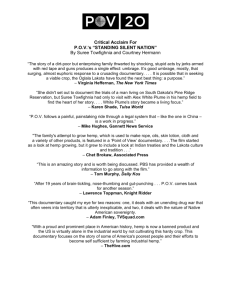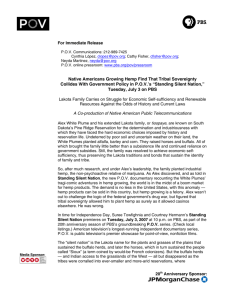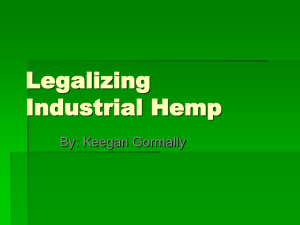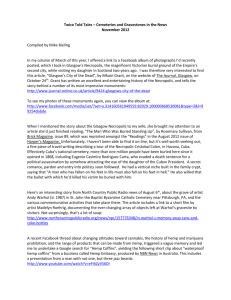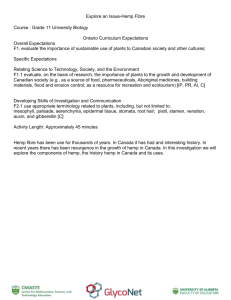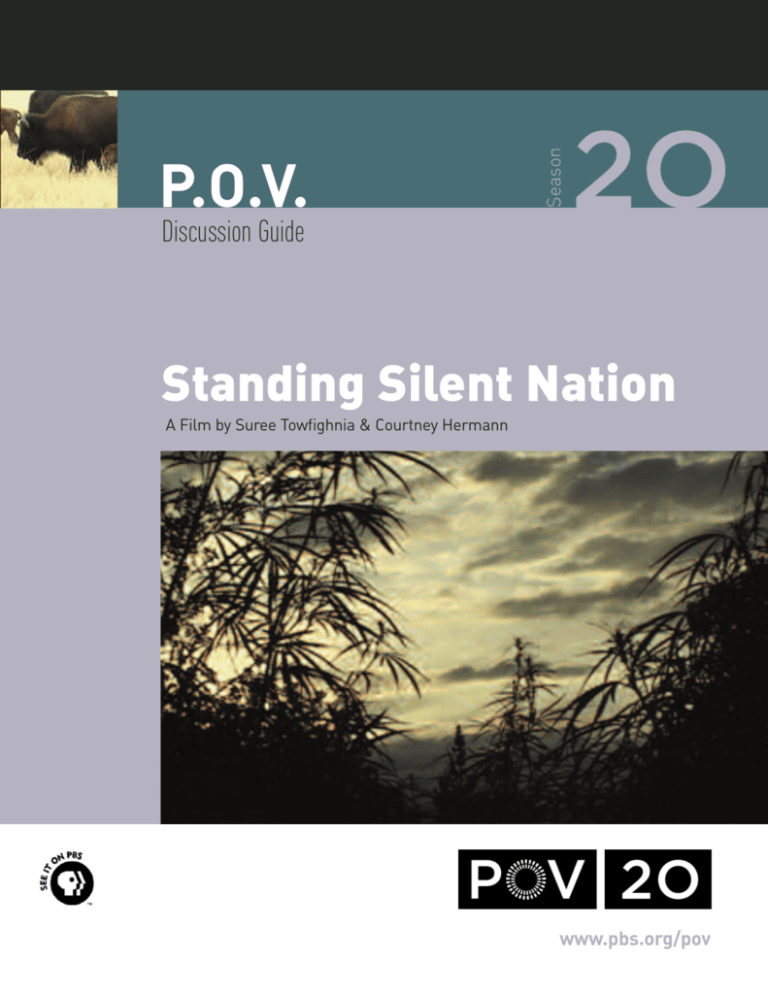
Season
P.O.V.
Discussion Guide
Standing Silent Nation
A Film by Suree Towfighnia & Courtney Hermann
www.pbs.org/pov
Season
Discussion Guide | Standing Silent Nation
Letter from the Filmmakers
Director Suree Towfighnia
Producer Courtney Hermann
Photo Sharon Karp
Photo Suree Towfighnia
Chicago and Portland, May 2007
Dear Colleague,
We started out with this question: If we can walk into The Body Shop and buy lotion made from hemp in the United States, why can’t
American farmers grow hemp?
Our research led us to farmer-activists who questioned the U.S. government policy of paying subsidies to farmers to NOT cultivate
overabundant crops, such as corn and soybeans, yet putting a ban on growing a fiber crop that has thousands of uses, none of them
drug-related.
It didn’t take long for us to follow this issue down a different but related path, which ended on the back porch of a small house on
the Pine Ridge Indian Reservation, home of the Oglala Lakota.
On August 10, 2002, we traveled from Chicago through the Badlands of South Dakota. After passing buffalo fences and a horse corral,
we pulled into a dusty driveway, where we were greeted by Alex White Plume, who apologized for being in a bad mood on such a
beautiful day. He informed us that 10 minutes earlier the DEA had served him with a summons detailing eight federal charges
against him. We asked Alex if we could put a microphone on him. He obliged, and we started filming.
Alex was the first person to grow industrial hemp within the borders of the United States in over 40 years. His previous two years of
cultivation had ended in DEA raids. And yet he planted again this third year. Why?
The more we got to know the White Plume family—whom we would work with over the next five years—the more we became
conscious of the many forces that shape and challenge them. Life on the reservation is characterized by hope, community,
© American Documentary, Inc.
2
Season
Discussion Guide | Standing Silent Nation
Letter from the Filmmakers
spirituality, beauty, struggle, strength, oppression,
lack of opportunity, historical trauma, and all the ills
stemming from poverty that are difficult for some to
imagine really exist within the United States.
As often happens with documentary, our story found
us. The White Plumes’ hemp cultivation was what
drew us to their land, but we quickly realized that
hemp is only a part of the larger story of this one
family’s efforts to maintain their values and their way
of life. When we arrived on the reservation, we were
ignorant about the sovereignty of Indian Nations and
the existence of tribal governments. We had little
understanding of the strong bonds of culture, history,
and tradition that the Lakota share, or of their tightknit family structures. However, after Debra White
Plume agreed to sign on as our Associate Producer
we were confident the story would be crafted authen-
Director Suree Towfighnia with Andrew Piccone and Matt Gossage.
tically.
Photo Ben Steiger
What we found in Alex White Plume’s experiences
symbolized the struggle for sovereignty and showed us a man whose daily actions model the values he seeks to preserve on the
reservation, either intentionally for the benefit of the younger generations, or unintentionally as he navigates his way through the
series of federal roadblocks placed in the way of his path to a sustainable economy.
Documentary filmmaking requires faith—in your story, in yourself, in the subject, in your ability to get it done, and in the belief that
somehow people will actually see the film and be changed by it. Standing Silent Nation aims to empower our audience to work to
create social change for all people in order to ensure the sustainability of cultures, and historical traditions for future generations.
Suree Towfighnia and Courtney Hermann
Filmmakers, Standing Silent Nation
© American Documentary, Inc.
3
Table of Contents
5
6
6
7
8
10
11
13
14
16
17
19
Introduction
Background Information
Defining Tribal Sovereignty
Hemp
White Plume Lawsuit
The Lakota Nation
Selected People Featured in
Standing Silent Nation
General Discussion Questions
Discussion Prompts
Taking Action
Resources
How to Buy the Film
Season
Discussion Guide | Standing Silent Nation
Credits, Acknowledgements
Writer
Faith Rogow, PhD
Insighters Educational Consulting
Research Editor
Kris Wilton
Guide Producers, P.O.V.
Eliza Licht
Director, Community Engagement and Education, P.O.V.
Shabnam Ahamed
Outreach and Development Coordinator, P.O.V.
Irene Villaseñor
Youth Views Manager, P.O.V.
Design: Rafael Jiménez
Copy Editor: Kristin M. Jones
Thanks to those who reviewed this guide:
Penny Costello,
Project Coordinator, Native American Public
Telecommunications
Courtney Hermann,
Prairie Dust Films
Rita Pyrillis (Cheyenne River Sioux),
Journalist and Native American Public Telecommunications
Board Member
Shirley K. Sneve (Rosebud Sioux),
Executive Director, Native American Public Telecommunications
Suree Towfighnia,
Prairie Dust Films
Debra and Alex White Plume (Oglala Lakota),
Bring Back the Way
© American Documentary, Inc.
4
Season
Discussion Guide | Standing Silent Nation
Introduction
What does a family have to endure to create a future for itself?
Freedom White Plume drives horses into White Plume corral.
Photo Suree Towfighnia
If you are a Lakota family intent on growing industrial hemp, the
answer is, quite a lot.
The feature-length (hour-long) film Standing Silent Nation
But the Oglala Lakota have tribal sovereignty. They passed an
chronicles the efforts of Alex White Plume and his family to
ordinance legalizing the cultivation of industrial hemp on the
develop a sustainable economy on the Pine Ridge Reservation
reservation. So when federal agents raided the White Plumes’
in South Dakota. Because the land is unsuitable for most crops,
fields, their actions swept the family and the Lakota Nation into
they placed their hopes in industrial hemp, a hardy fiber crop
a struggle over the meaning of historic treaties and control over
used in many products for which there is a booming worldwide
tribal lands.
demand.
As an outreach tool, this compelling portrait of one family’s
White Plume knew that, despite industrial hemp’s nonpsy-
struggle for economic self-sufficiency will help viewers
choactive properties, the Controlled Substances Act (1970)
examine wide-ranging issues, from the logic behind the U.S.’s
classifies the plant as an abusable drug, like heroin or
“war on drugs” to the rocky, historic relationship between the
marijuana. As a result, growing hemp is illegal in the U.S.
federal government and indigenous nations.
© American Documentary, Inc.
5
Season
Discussion Guide | Standing Silent Nation
Background Information
Defining Tribal Sovereignty
The Washington State Governor’s Office of Indian Affairs
provides this helpful description of Tribal Sovereignty:
American Indian Tribes are recognized in federal law
as possessing sovereignty over their members and
their territory. Sovereignty means that tribes have the
power to make and enforce laws, and to establish
courts and other forums for resolution of disputes.
The sovereignty that American Indian Tribes possess
is inherent, which means that it comes from within the
tribe itself and existed before the founding of the
United States. Tribal sovereignty is not absolute, but
rather is subject to certain limits resulting from the
unique relationship of the tribes to the United States.
Under federal law, tribes retain all those aspects of
their original sovereignty except aspects that have
been given up in a treaty, taken away by an act of
Congress, or divested by implication as a result of
their dependent status.
In addition to inherent sovereignty, tribal governments
may also exercise authority delegated to them by
Congress. Key principles of sovereignty include:
•
Tribal Sovereignty is the right of tribes, as “domestic
dependent nations,” to exercise self-determination
and the right to self-government, unless these powers
have been modified by treaty or by an act of Congress.
Sovereignty ensures control over the future of the
tribes and encourages preservation of tribal culture,
religions, and traditional practices.
•
Tribes have the authority to, among other things,
govern their people and their land; define their own
Tipi near the White Plume's corral.
tribal membership criteria; create tribal legislation
Photo Kerribeth Elliott
law enforcement, and court systems; and to impose
taxes in certain situations.
•
Membership in a sovereign tribe is what distinguishes
Sources:
American Indians as a political group rather than
www.goia.wa.gov/Government-to-Government/Data/SectionI.htm
solely an ethnic minority.
© American Documentary, Inc.
6
Season
Discussion Guide | Standing Silent Nation
Background Information
Hemp
Commonly confused with marijuana, hemp is an
easy-to-grow plant whose stalks, seeds, and oil
can be used to produce a range of goods
including food, body-care products, clothing,
rope, paper, and biofuel.
Production of hemp, which was grown by the
United States’ “founding fathers,”
was first
complicated in the U.S. by tax and licensing
regulations imposed by the 1937 Marijuana Tax
Act. During World War II, when foreign hemp
supply
lines
were
blocked,
the
federal
government launched “Hemp for Victory,” a
campaign that encouraged farmers to cultivate
the crop once again. About a million acres of
hemp were grown across the Midwest, but after
the war the processing plants were quietly shut
down and the industry faded away.
Hemp cultivation continues in much of the rest
of the world, but it is restricted in the United
States because, like marijuana, it is in the
Cannabis sativa plant family. However, while
Surviving hemp plants.
marijuana contains as much as 20 percent
Photo Kerribeth Elliott and Suree Towfighnia
tetrahydrocannabinol (THC), the plant’s chief
intoxicant, hemp can be bred to contain as little as 0.3 percent—
Sources:
not enough to produce a psychoactive effect.
“Bird Food Is a Casualty of the War on Drugs.” Wren, Christopher S.
There are currently more than 25,000 identified uses for
The New York Times, October 3, 1999.
industrial hemp, and importation of them is legal. The United
“Hemp and Marijuana: Myths and Realities.” West, David P., Ph.D.
States imports over $1.3 million worth of hemp products from
North American Industrial Hemp Council.
other nations that regulate hemp production. U.S. retail sales of
“Hemp Is Hip, Hot, and Happening, So Why Are American Farmers Being Left
these goods are now estimated to be between $250 and $300
million annually.
Seven states (Hawaii, Kentucky, Maine, Maryland, Montana,
North Dakota, and West Virginia) have passed pro-hemp
farming laws. The Industrial Hemp Farming Act of 2007, a bill
that would remove restrictions on cultivating nonpsychoactive
industrial hemp on United States farms, has been introduced in
Congress.
© American Documentary, Inc.
Out?” Special advertising section in Utne Reader, September–October 2004.
Sponsored by hempindustries.org: www.thehia.org.
“Industrial Hemp: Global Markets and Prices.” Vantreese, Valerie.
University of Kentucky, Department of Agricultural Economics, 1997.
http://www.votehemp.com/PDF/hemp97.pdf
Introduction of the Industrial Hemp Farming Act of 2007:
http://thomas.loc.gov/cgi-bin/query/z?r110:E13FE7-0027
“The Hemp Vote.” Leibovich, Mark. The New York Times, February 20, 2007.
VoteHemp.org
7
Season
Discussion Guide | Standing Silent Nation
Background Information
Alex White Plume at his horse corral.
Photo Courtney Hermann
White Plume Lawsuit
acres. In addition to having been granted permission by the
In the late 1990s, a group on the impoverished Pine Ridge
mandate of the tribal ordinance, the White Plumes believed that
Reservation called the Slim Butte Land Use Association
they were asserting their treaty rights as outlined in the Fort
developed a plan to create jobs and housing using industrial
Laramie Treaty of 1868, which encouraged the Lakota to use the
hemp. They began by purchasing hemp from Canada, where it
land to grow sustainable crops.
is grown legally.
In August of that year, just days before the family was to harvest
In order for the project to be economically viable and
the crop, DEA and FBI agents, U.S. Marshalls, and U.S. District
sustainable, the Oglala decided that they would have to grow
Attorneys confiscated the plants at gunpoint. A federal judge
their own hemp. The Oglala Sioux Tribal Council passed an
later refused to return the plants, but no charges were brought
ordinance in 1998 legalizing the cultivation of the plant with THC
against the White Plumes. The next year they planted again,
levels at or below 1 percent, well below the levels that give
and again the DEA confiscated the crop just days before its
marijuana its psychoactive effects.
planned harvest, but still no charges were filed.
In 2000, Alex White Plume and his tiospaye (“family” in Lakota)
In 2002, the White Plumes planted a 3.5-acre crop, and this time
procured some low-THC seed and planted a test plot of 1.5
the agents did not raid the field. However, four days before the
© American Documentary, Inc.
8
Season
Discussion Guide | Standing Silent Nation
Background Information
scheduled harvest, DEA agents entered the White Plume home
Sources:
and served Alex with civil charges and a temporary restraining
“Appeals Court Rules Against Pine Ridge Hemp Growing.” Walker, Carson.
order that prevented his family from possessing, manufac-
Associated Press, May 18, 2006.
turing, or distributing marijuana.
“Federal Judge Calls DEA’s Views on Hemp Farming ‘Asinine’ in Case over
On October 16, 2002, the federal government sought to make
Industrial Hemp and Tribal Sovereignty.” U.S. Newswire, December 16, 2005.
that temporary order permanent, preventing the family from
“For the People, Earth, and Sovereignty: Hemp Struggles Leave White Plume
growing the crop without federal permission. The government
Tiospaye Spent.” Tudor, Elizabeth. The Native Voice, October 23, 2002.
argued that because hemp is no different from marijuana, it
“Judge Issues Restraining Order Against Hemp Growers.” Associated Press,
falls under the same restrictions. The White Plumes countered
August 14, 2002.
that hemp is indeed different from marijuana and that the Fort
“The Drug War Comes to the Rez.” Broydo, Leora. Mother Jones, February 13,
Laramie Treaty of 1868 allows the Lakota to grow whatever
2001.
crops they like.
U.S. Court of Appeals for the Eighth Circuit, CIV 02-5071-RHB.
In December 2004, the court found for the U.S.
government, finding that neither of the White
Plumes’ arguments was valid. The White
Plumes appealed, presenting their case before
the Eighth Circuit Court of Appeals on December
12, 2005. Bruce Ellison and David Frankel argued
to a three-judge panel that the injunction
preventing the farming of industrial hemp
should be overturned on the basis that the plant
was legal when the Oglala Sioux signed the Fort
Laramie treaties of 1868 and 1851 with the U.S.
and is still allowed by tribal law. The U.S.
government argued that its “trust responsibility”
gives it the final say for what are appropriate
uses of tribal lands.
The judges recognized the irony of legalizing
importation of hemp while prohibiting its
cultivation in the U.S. and acknowledged the
Alex White Plume searches for a lost buffalo with field glasses.
Photo Courtney Hermann
lack of economic opportunity on the Pine Ridge
Reservation, but on May 17, 2006, the appeals court ruled that
growing the crop was illegal according to U.S. law and is not
provided for in the Fort Laramie Treaty of 1868. Pursuit of
further legal challenges is hampered by the possibility that
Court rulings would further erode sovereignty rights, so the
White Plumes and others are turning their attention to
legislative action.
© American Documentary, Inc.
9
Season
Discussion Guide | Standing Silent Nation
Background Information
The Lakota Nation
The Oglala are one of seven bands of
Lakota, a Sioux tribe. About 18,000
Oglala Lakota live on the Pine Ridge
Reservation, between the Black Hills
and
Badlands
National
Park
in
southwestern South Dakota.
The reservation is part of land
designated
as
the
Great
Sioux
Reservation by the U.S. government in
the Fort Laramie Treaty of 1868.
According to the Treaty, the Lakota
were allotted about half of present-day
South Dakota “for absolute and
undisturbed use and occupation” by
View from the road on Pine Ridge Reservation.
the Lakota people, as well as rights to
Photo Suree Towfighnia and Courtney Hermann
hunting
grounds
in
Nebraska,
Wyoming, and Montana.
In the decades following the original agreement, the U.S.
recognizes the tribal government as sovereign, and the
government confiscated additional parcels of land. In 1877,
agreement between the tribe and the U.S. is defined as one
under threat of starvation due to dwindling buffalo herds and a
between two governments, the U.S. continues to exert power
threatened withdrawal of vital government aid, tribal leaders
over the tribes, especially because the tribe is dependent on
ceded the mineral-rich Black Hills to Congress. The Lakota
federal aid.
also ceded some land in exchange for a promise of seeds and
agricultural aid.
In 1889 Congress divided up the remaining land into separate
reservations for the Lakota tribes. Of the 3 million acres
originally making up Pine Ridge, less than half are still in Oglala
hands. Some were sold; some were leased to white ranchers.
The land retained by the tribe is largely barren. Unemployment
among the Oglala runs as high as 85 percent—more than
Sources:
“Land, Hemp, and Sovereignty at Pine Ridge: The Oglala Lakota Fight Federal
Obstruction.” Weinberg, Bill. Native Americas, August 31, 2001.
“On Pine Ridge, a String of Broken Promises.” Nieves, Evelyn. Washington Post,
October 21, 2004.
“The Case for Hemp.” LaDuke, Winona. Indian Country Today (Lakota Times),
September 19, 2001.
fifteen times the U.S. national average. Most of the reservation
lives below the federal poverty line, with two-thirds of the
residents living in substandard housing. While general life
expectancy in the U.S. is 75–80, on the reservation it is 47–56.
The Lakota are governed by a five-member executive
committee and an 18-member council. Leaders are elected and
serve four-year terms. Although the 1868 Fort Laramie Treaty
© American Documentary, Inc.
10
Season
Discussion Guide | Standing Silent Nation
Background Information
Selected People Featured in Standing Silent Nation
Alex
Debra
Ramona
Gabe
The White Plumes: Alex, his wife Debra, his sister Ramona, and his nephew Gabe
The first people to grow industrial hemp within the boundaries of the United States in over 40 years. The White Plumes continue
their work on indigenous peoples’ issues. See the Resources section for links to specific organizations and initiatives.
© American Documentary, Inc.
11
Season
Discussion Guide | Standing Silent Nation
Background Information
Selected People Featured in Standing Silent Nation
Vic Camp
Mashanoposhe Camp
Tom Ballanco
Bruce Ellison
Lakota Youth Activist, radio
Alex’s nephew
Attorney defending the
Attorney defending the
announcer, and Alex’s
White Plumes and the
White Plumes and the
nephew
Lakota Nation
Lakota Nation
James Woolsey
Mark Kleiman
Former CIA Director, 1993–
Drug Policy Analyst
1995
© American Documentary, Inc.
12
Season
Discussion Guide | Standing Silent Nation
General Discussion Questions
Immediately after the film, you may want to give people a
few quiet moments to reflect on what they have seen. If the
mood seems tense, you may want to pose a general question
and give people some time to themselves to jot down or think
about their answers before you open the discussion.
Unless you think participants are so uncomfortable that they
can’t engage until they have had a break, don’t encourage
people to leave the room between the film and the
discussion. If you save your break for an appropriate
moment during the discussion, you won’t lose the feeling of
the film as you begin your dialogue.
One way to get a discussion going is to pose a general
question such as:
•
If you could ask anyone in the film a single question,
whom would you ask and what would you ask them?
•
If a friend asked you what this film was about, what
would you tell them?
•
Did anything in this film surprise you? If so, what? Why
was it surprising?
•
What insights or inspiration did you gain from this film?
What did you learn about the film’s subjects and/or
about yourself?
Debra White Plume, Associate Producer, “Standing Silent Nation.”
Photo courtesy of “Standing Silent Nation”
© American Documentary, Inc.
13
Season
Discussion Guide | Standing Silent Nation
Discussion Prompts
Hemp & U.S. Government Policy
•
Who benefits from and who is harmed by U.S. policy
prohibiting the growth of industrial hemp?
•
Should the U.S. government continue to prevent Alex
White Plume from farming industrial hemp? Why or why not?
How do you think life for the White Plumes would change if they
were allowed to grow industrial hemp?
•
In your view, if Alex White Plume or others on the
reservation continue to cultivate hemp, what should happen to
them?
•
Debra White Plume says, “I didn’t like seeing them with
their guns around our children, with their guns on our land,
with their guns standing against the youth of our families.”
Imagine what it would feel like to have armed agents coming in
to your home. What do you think your reaction might have been
if you were in Debbie’s or Alex’s shoes?
•
What is your reaction to the timing of the DEA raids (just
before the crop is ready to harvest)?
•
It is clear from the film that industrial hemp grows wild. It
has even reseeded itself on the White Plume land. In terms of
federal policy and what people are permitted to harvest, should
there be distinctions between plants that are cultivated and
plants that grow naturally?
Hemp plant tagged for THC testing.
Photo Suree Towfighnia
Director Suree Towfighnia with Mato Thompson, Rosebud White
Plume and Terry Thompson.
Photo Courtney Hermann
© American Documentary, Inc.
14
Season
Discussion Guide | Standing Silent Nation
Discussion Prompts
Sovereignty
•
Alex White Plume describes a “sovereign nation” as
having language, land, culture, government, and a police
force. What does nationhood mean to you? How would you
define it? Why is sovereignty important?
•
Journalist Mark Trahant asks President Bush, “What do
you think tribal sovereignty means in the 21st century?” How
would you answer that question? Should there be limits to
tribal sovereignty? If so, why, and what should those limits be?
•
Debra White Plume says, “In our treaties with America,
Alex White Plume working on field sitting on a tractor.
we retained our sovereignty. It’s not something America gave
Photo courtesy of “Standing Silent Nation”
us. Sovereignty can never be given to anyone.” Where does
sovereignty come from? How is it preserved or enforced?
•
On his radio show, Vic Camp says, “You know, it is 4th of
President Clinton said, “We’re not coming from
July weekend and maybe some people want to celebrate
Washington to tell you exactly what to do and how to do it. We’re
America’s independence. For me it’s a day of mourning.” If you
coming from Washington to ask you what you want to do and
were in charge of planning an Independence Day observance in
tell you we want to give you the tools and the support to get
a community that included people who shared Vic’s perspective,
done what you want to do for your children and their future.”
how might you honor their perspective while also honoring the
How is this style of help different than the descriptions of
perspective of those who see U.S. independence as a cause for
government aid you hear about in the film? What might aid
celebration?
programs look like if they were designed to reflect Clinton’s
•
•
From what you see in the film, how would you describe
description?
Alex’s view of family? How is this similar to or different from
•
your own view?
How might the U.S. government benefit from keeping
American Indians dependent on federal aid? How might the
•
government be harmed by that dependence? How are the
doing. What do their actions suggest about how the community
As you watch the film, list the things that you see children
recipients of the aid either benefited or harmed by such
views children and childhood? How do these beliefs compare to
dependence?
your own?
•
•
Alex White Plume says that his actions are “about a fight
How do Alex’s neighbors, friends, family, and community
for freedom.” If he is correct, what are the implications for
get news? How important are news media to a community?
America’s self-image as a defender of freedom?
What role do news media play in your community?
•
The Lakota
•
What was your first reaction when you heard Ramona
White Plume say, “People believe that because Indians have
casinos that we are rich, but we’re not”? When you think of
Indians, what images come to mind? What are the sources of
Prior to viewing the film, what did you know about the
Lakota? What images came to mind when you heard the words
“Indian” or “Native American?” Where did your ideas or images
come from (what was their source)? In what ways did the film
challenge or affirm your ideas?
•
What might others learn from the White Plumes’
those images or ideas? How accurate or reliable are those
approach to their land? What lessons do their beliefs and
sources?
actions hold for policy makers?
© American Documentary, Inc.
15
Season
Discussion Guide | Standing Silent Nation
Taking Action
•
Convene a public debate or town
meeting on the Industrial Hemp
Farming Act and the current bill in
Congress,
H.R.
3037.
Encourage
participants to share their views with
their members of Congress.
•
To explain her relationship to the
land, Debra White Plume quotes Crazy
Horse, “We don’t own the earth, we
borrow her from our children.” Craft
sample public environmental policies
based on that idea. Choose at least one
of the policies as a focus and work
toward its implementation.
•
Find out how and what your
school district teaches about Native
Americans. Work with local tribes
and/or Native American organizations
to ensure that the curriculum is
complete and accurate.
•
Explore human-rights issues
related to American Indians. Include in
your research the impact of the Papal
Bull document of 1492 (which stated
that any non-Christians could be
Ramona White Plume and Attorney Tom Ballanco leaving court.
Photo courtesy of “Standing Silent Nation”
declared animals and therefore could
not own land) and the decade-long effort to pass a United
Nations declaration of indigenous people’s rights.
•
Use the film as a catalyst for public discussions about
what people can learn about community activism from the
White Plumes. Invite local activists to share their own
experiences.
© American Documentary, Inc.
16
Season
Discussion Guide | Standing Silent Nation
Resources
What’s Your P.O.V.?
FILM-RELATED WEB SITES
P.O.V.’s online Talking Back Tapestry is a colorful,
interactive representation of your feelings about
Standing Silent Nation .
Listen to other P.O.V. viewers talk about the film
and add your thoughts by calling 1-800-688-4768.
www.pbs.org/pov/talkingback.html
Original Online Content on P.O.V. Interactive
(www.pbs.org/pov)
P.O.V.’s Standing Silent Nation Web site
www.pbs.org/pov/standing
The Standing Silent Nation companion Web site offers a
streaming video trailer of the film, an interview with filmmakers
Suree Towfighnia and Courtney Hermann (video, podcast and
text); a list of related Web sites, organizations and books; a
the creation, promotion and distribution of Native public media.
downloadable discussion guide and classroom activity; and the
Other award-winning services of NAPT include the AIROS
following special features:
Native Network, www.airos.org, and Visionmaker Video,
ADDITIONAL SCENES
Watch exclusive video not included in the film including
www.visionmaker.org, distributor of authentic documentaries
by and about Native Americans.
the original trailer that focuses on the history of hemp
production in America, scenes from a protest that the
HEMP
White Plume family participated in during the 2003
reenactment of the Lewis and Clark expedition and an
VOTE HEMP
expanded interview with former CIA director James
www.votehemp.com/
Woolsey on the laws surrounding hemp production.
Vote Hemp is a nonprofit organization dedicated to changing
FILM UPDATE
Find out what has happened to the White Plume family
since filming stopped in a video interview with Alex White
Plume.
U.S. law to allow for the growth and sale of industrial hemp. The
Web site includes basic information about industrial hemp, as
well as a timeline of the White Plume Case and links to
corresponding legal documents and news coverage.
THE HEMP INDUSTRIES ASSOCIATION
Standing Silent Nation
http://thehia.org/
The Hemp Industries Association is a nonprofit trade
Prairie Dust Films
www.prairiedustfilms.com
association representing hemp companies, researchers, and
supporters. Resources include a country-by-country summary
The filmmakers’ Web site includes links to related resources as
of hemp policies around the world and information on pending
well as news updates on the film.
legislation, the Industrial Hemp Farming Act of 2007 (H.R. 1009).
NATIVE AMERICAN PUBLIC TELECOMMUNICATIONS
DEPARTMENT OF JUSTICE’S DRUG ENFORCEMENT AGENCY
www.nativetelecom.org
www.usdoj.gov/dea/index.htm
Native American Public Telecommunications (NAPT) is one of
The Web site of the Department of Justice’s Drug Enforcement
five national consortia chartered by the Corporation for Public
Agency includes the text of the Controlled Substance Act.
Broadcasting (CPB) to provide minority programming to the
Search for “hemp” to find relevant news reports and policy
public broadcasting system. For 30 years, NAPT has supported
statements relevant to the White Plume case.
© American Documentary, Inc.
17
Season
Discussion Guide | Standing Silent Nation
Resources
THE LAKOTA NATION & TRIBAL
SOVEREIGNTY
OWE AKU (BRING BACK THE WAY)
www.bringbacktheway.com
THE NATIVE AMERICAN RIGHTS FUND
www.narf.org
The Native American Rights Fund is a nonprofit law firm
dedicated to defending Native American rights. The Web site
includes the National Indian Law Library, an extensive
The White Plume family’s site highlights their activism work
collection of legal documents, including documents related to
and lists ways that people can contact and help them.
events featured in the film.
INTER-TRIBAL COALITION TO DEFEND BEAR BUTTE
INDIAN LAND TENURE FOUNDATION
www.defendbearbutte.org
www.indianlandtenure.org
This Lakota Web site supports protection of the sacred Mato
The Web site of the Indian Land Tenure Foundation includes
Paha—Bear Butte Mountain—in South Dakota, an effort the
historical and current information about tribal land rights and
White Plume family champions.
sovereignty issues.
OGLALA SIOUX TRIBE
UNITED NATIONS PERMANENT FORUM ON INDIGENOUS
http://lakotamall.com/oglalasiouxtribe/index.htm
ISSUES
The Oglala Sioux Tribe’s Web site includes information about
www.un.org/esa/socdev/unpfii
their government, history, schools, and land, as well as news.
LAKOTA TREATY OF FORT LARAMIE, 1851
http://puffin.creighton.edu/lakota/1851_la.html
Debra White Plume serves as a delegate to the United Nations
Permanent Forum on Indigenous Issues. The Forum’s Web site
includes a Declaration of Rights as well as records of
proceedings regarding indigenous issues around the world.
This academic Web site provides the full text of the Fort
Laramie Treaty of 1851.
NATIONAL CONGRESS OF AMERICAN INDIANS
www.ncai.org/
THE BUREAU OF INDIAN AFFAIRS
www.doi.gov/bureau-indian-affairs.html
Since 1944, the National Congress of American Indians has
been working to inform the public and Congress on the gov-
The Bureau of Indian Affairs is responsible for administering
ernmental rights of American Indians and Alaska Natives.
services and managing land held in trust by the U.S.
Now serving as the major national tribal government organi-
government for American Indian tribes. Due to litigation, most
zation, NCAI is positioned to monitor federal policy and coordi-
of the Web site’s resources are currently offline.
nated efforts to inform federal decisions that affect tribal gov-
NATIVES UNITE: HEMP AT PINE RIDGE
ernment interests. Their site includes a tribal directory, an
http://nativesunite.org/hemp/
update on policy issues as well as an archive of news articles
This part of the Natives Unite Web site focuses on the White
on issues affecting American Indians.
Plume legal case and includes a downloadable copy of the final
judgment explaining the court’s position.
© American Documentary, Inc.
18
Season
Discussion Guide | Standing Silent Nation
How to Buy the Film
To order Standing Silent Nation,
go to www.visionmaker.org or www.standingsilentnation.com
Produced
by
American
Documentary, Inc. and entering its
20th season on PBS, the awardwinning P.O.V. series is the longest-running series on television to
feature the work of America’s best contemporary-issue independent
filmmakers. Airing Tuesdays at 10 p.m., June through October, with
primetime specials during the year, P.O.V. has brought over 250 awardwinning documentaries to millions nationwide, and now has a Webby
Award-winning online series, P.O.V.’s Borders. Since 1988, P.O.V. has
pioneered the art of presentation and outreach using independent
nonfiction media to build new communities in conversation about
today’s most pressing social issues. More information about P.O.V is
available online at www.pbs.org/pov.
P.O.V. Community Engagement and Education
P.O.V. provides Discussion Guides for all films as well as curriculumbased P.O.V. Lesson Plans for select films to promote the use of
independent media among varied constituencies. Available free online,
these originally produced materials ensure the ongoing use of P.O.V.’s
documentaries with educators, community workers, opinion leaders
and general audiences nationally. P.O.V. also works closely with local
public-television stations to partner with local museums, libraries,
schools and community-based organizations to raise awareness of the
issues in P.O.V.’s films.
P.O.V. Interactive
www.pbs.org/pov
Major funding for P.O.V. is provided by the John D. and Catherine T
MacArthur Foundation, the National Endowment for the Arts, the New
York State Council on the Arts, the Ford Foundation, the Educational
Foundation of America, PBS and public television viewers. Funding for
P.O.V.s Diverse Voices Project is provided by the Corporation for
Public Broadcasting, with additional support from JPMorgan Chase
Foundation, the official sponsor of P.O.V.'s 20th Anniversary
Campaign. P.O.V. is presented by a consortium of public television
stations, including KCET Los Angeles, WGBH Boston, and
Thirteen/WNET New York. Simon Kilmurry is executive director of
American Documentary | P.O.V.
The P.O.V. 20th Anniversary Collection
is a limited-edition DVD collection
produced in partnership with Docurama.
The collection contains 15 titles
reflecting the range and diversity of
P.O.V. films, including the series'
inaugural broadcast, American Tongues,
by Louis Alvarez and Andrew Kolker.
Available at www.amdoc.org/shop.
P.O.V.’s award-winning Web department produces a Web-only
showcase for interactive storytelling, P.O.V.’s Borders. It also produces
a Web site for every P.O.V. presentation, extending the life of P.O.V. films
through community-based and educational applications, focusing on
involving viewers in activities, information and feedback on the issues.
In addition, www.pbs.org/pov houses our unique Talking Back feature,
filmmaker interviews, viewer resources and information on the P.O.V.
archives as well as myriad special sites for previous P.O.V. broadcasts.
American Documentary, Inc.
www.americandocumentary.org
American Documentary, Inc. (AmDoc) is a multimedia company
dedicated to creating, identifying and presenting contemporary stories
that express opinions and perspectives rarely featured in mainstreammedia outlets. AmDoc is a catalyst for public culture, developing
collaborative strategic-engagement activities around socially relevant
content on television, online and in community settings. These activities
are designed to trigger action, from dialogue and feedback to
educational opportunities and community participation.
Front cover: Hemp in silhouette at dawn.
Photo Suree Towfighnia
The See it On PBS logo is a trademark of the Public Broadcasting Service and is used with permission. All rights reserved.

